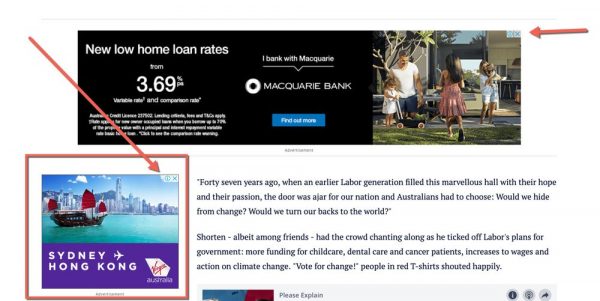Google Display Network for Brand Awareness
When getting started with digital marketing tools, chances are you’ve probably already heard of Google Ads. What not a lot know though is that they branch out into two – Search and Display. While a search campaign shows text ads on search engine results (Search Network), a Google Display campaign is the more visual approach of showing banner/video ads in over 2 million partner websites, videos, and apps (Display Network).
A valuable marketing platform, Google’s Display Networks reaches over 90% of internet users and it takes the form of visual banner ads as seen below.

Search Ads vs. Display Ads
What sets both networks apart?
While the Search Ads taps into users directly and actively searching into Google’s Search Engine or other partner search sites. This means that there is already intent in the minds of the users to search for that particular item.
Display Ads, on the other hand, are more passive as they usually appear when users are just going about their usual internet activity such as skimming through a news article, watching video clips, and the like. These ads are mainly small banners or boxes following you around as you scroll through a site. This means that the primary interest of the user is the website content itself and the display ads are just merely secondary. The main difference is that the users aren’t directly on ‘shopping mode’ and may not be familiar with your brand at all. This is because the Google Display Network is a tool that can be used for prospecting and brand awareness.
Due to the low-intent nature of the users when encountering Display Ads, the click-through-rate (CTR) and conversion rate are often below 1%. But the advantage here is the wide array of targeting options that go beyond keywords, and the ability to access a good portion of internet users due to the numerous website placements. The result is finding a tighter network audience with more relevant targeting.
Prospecting and Remarketing
There are two ways to target using Google Display Ads:
(1) First is through prospecting which happens when internet users who may have no previous knowledge of your brand, product, or services are targeted.
(2) The other is through remarketing, which targets users who have engaged with your website in some form previously.
The latter is often referred to as the best way to optimize Display Ads, this option makes use of the audiences found in Google Analytics to help find your target market. These remarketed audiences take place in many forms such as website visitors, users who downloaded content or submitted forms, users who signed up for free trials or other offers, and users who have completed transactions previously. This is why it is said that remarketing completes the circle of engagement as it helps keep past visitors who took interest in a certain product or service to see targeted ads and eventually lead them to make that purchase.
—
We have laid out the basic need-to-knows about Google’s Display Network, perfect for any business that wants to get their brand or service out there to wider audiences. While Search Ads target those actively looking for products, who knows if you might bag the right market with you through the more passive Display Ads.
In the end, it all depends on your company’s marketing goals and knowing what type of ad or strategy to utilize. While it may seem scary to venture into Google Ads alone, there are always agencies out there to help you with your marketing goals. iManila is a Google Partner agency that can help you navigate Google’s diverse marketing platforms to reach your audience and deliver optimal results! Feel free to drop us a message at info@imanila.ph and kick start your digital marketing journey with us.




